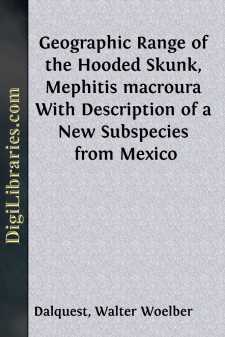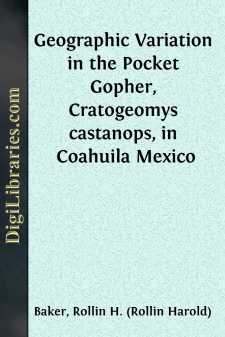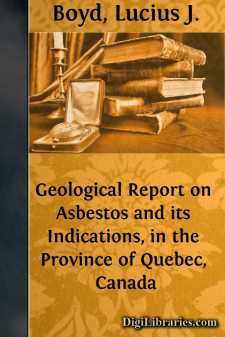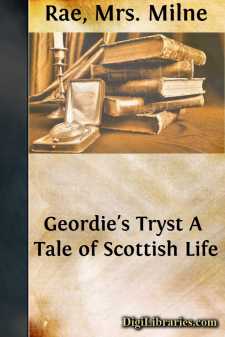Fiction
- Action & Adventure 180
- Biographical 15
- Christian 59
- Classics
- Coming of Age 5
- Contemporary Women 3
- Erotica 8
- Espionage/Intrigue 12
- Fairy Tales, Folklore & Mythology 236
- Family Life 169
- Fantasy 117
- Gay 1
- General 596
- Ghost 32
- Historical 808
- Horror 43
- Humorous 160
- Jewish 25
- Legal 4
- Medical 22
- Mystery & Detective 315
- Political 49
- Psychological 41
- Religious 64
- Romance 159
- Sagas 11
- Science Fiction 730
- Sea Stories 113
- Short Stories (single author) 537
- Sports 10
- Suspense 1
- Technological 8
- Thrillers 2
- Urban Life 31
- Visionary & Metaphysical 1
- War & Military 173
- Westerns 199
Classics Books
Sort by:
by:
John A. White
Capitalized color terms in the following accounts are of Ridgway, "Color Standards and Color Nomenclature," Washington, D.C., 1912. The measurements of the skull that were used in this study were made as shown in White (1953:566, fig. 1). These are: Greatest length of skull, zygomatic breadth, cranial breadth, length of nasals, length of lower tooth-row, condylo-alveolar length of mandible, and...
more...
by:
J. Knox Jones
In his "Revision of the pocket mice of the genus Perognathus," Osgood (1900:18-20) reviewed the distribution, as then known, of Perognathus fasciatus and recognized two geographic races—Perognathus fasciatus [fasciatus] Wied-Neuwied in eastern Montana and Wyoming and adjacent parts of North and South Dakota, and Perognathus fasciatus infraluteus Thomas, known only from the type locality at...
more...
The hooded skunk, Mephitis macroura Lichtenstein, can be distinguished from the only other species in the genus, Mephitis mephitis Schreber, by the larger tympanic bullae, in the white-backed color phase by having some black hairs mixed with the white hairs of the back, and in the black-backed phase by having the two white stripes widely separated and on the sides of the animal instead of narrowly...
more...
In the course of the preparation of a synopsis of the North American terrestrial microtines by one of us (Cockrum), and the completion of a Master's thesis on the geographical variation of the red-backed mice of Wyoming by the other (Fitch) we had occasion to study the red-backed mice of the southern Rocky Mountain region (see figure 1). Results of these studies are the recognition of two...
more...
The plateau pocket gopher, Cratogeomys castanops, inhabits open lands from southeastern Colorado southward onto the Mexican Plateau as far south as southern San Luis Potosà and southeastern Zacatecas and southeastward to the Coastal Plain of northern Tamaulipas. This species occurs at elevations from as low as 26 feet at Matamoras in Tamaulipas to as high as 8700 feet in valleys of south-eastern...
more...
by:
Lucius J. Boyd
HAVING been called upon to make a close and careful examination of the geological formations in the eastern townships of Garthby, Wolf'stown, and Coleraine, situated in the province of Quebec, Canada, I gave special attention to the distribution of the Asbestos-bearing rocks (serpentine), which have been, in my opinion, heretofore only partially traced. Perhaps this was owing to the difficulties...
more...
by:
Mrs. Milne Rae
CHAPTER I. GRACE CAMPBELL. was a chilly Scotch spring day. The afternoon sun glistened with fitful, feeble rays on the windows of the old house of Kirklands, and unpleasant little gusts of east wind came eddying round its ancient gables, and sweeping along its broad walks and shrubberies, sending a chill to the hearts of all the young green things that were struggling into life. On the time-worn...
more...
by:
Thomas Seccombe
GEORGE BORROW. It is a singular coincidence, perhaps, that during one and the same summer we should be celebrating centenaries of Samuel Pepys and George Borrow. Pepys died in the early summer of 1703; Borrow was born in July, 1803. Unlike each other in almost every respect, they are dui palor, as Borrow would say, in one very material point. The reputation of each of them has risen to such a...
more...
CASE 1. 1. Portrait of Robert Evans. Lent by Canon Evans, Bedworth. Father of G. E., and prototype of Adam Bede. 2. Diaries of Robert Evans (“Adam Bede”). Lent by Mr. Walter P. Evans, Leamington. CASE 2. 3. Portrait of Isaac P. Evans. Lent by Canon Evans, Bedworth. G. E’s brother; original of “Tom Tulliver.” 3a. Another portrait of Isaac P. Evans. Lent by Mr. W. P. Evans, Leamington....
more...
I. EARLY LIFE. The poet and the novelist write largely out of personal experience, and must give expression to the effects of their own history. What they have seen and felt, gives shape and tone to what they write; that which is nearest their own hearts is poured forth in their books. To ignore these influences is to overlook a better part of what they write, and is often to lose the explanation of...
more...











